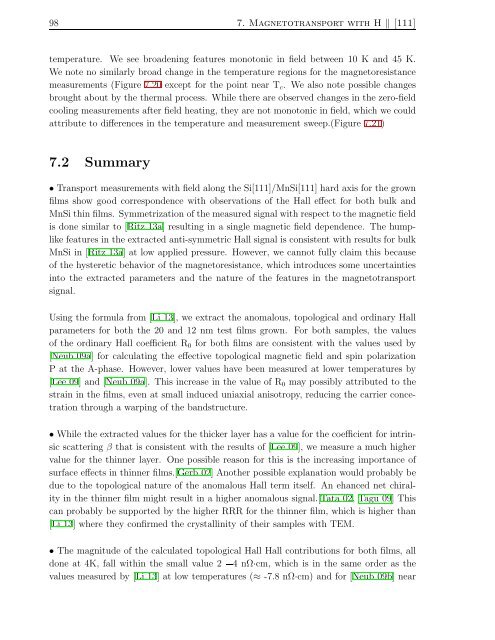As and Epitaxial-Growth MnSi Thin Films - OPUS Würzburg
As and Epitaxial-Growth MnSi Thin Films - OPUS Würzburg
As and Epitaxial-Growth MnSi Thin Films - OPUS Würzburg
Create successful ePaper yourself
Turn your PDF publications into a flip-book with our unique Google optimized e-Paper software.
98 7. Magnetotransport with H ‖ [111]<br />
temperature. We see broadening features monotonic in field between 10 K <strong>and</strong> 45 K.<br />
We note no similarly broad change in the temperature regions for the magnetoresistance<br />
measurements (Figure 7.20 except for the point near T c . We also note possible changes<br />
brought about by the thermal process. While there are observed changes in the zero-field<br />
cooling measurements after field heating, they are not monotonic in field, which we could<br />
attribute to differences in the temperature <strong>and</strong> measurement sweep.(Figure 7.21)<br />
7.2 Summary<br />
• Transport measurements with field along the Si[111]/<strong>MnSi</strong>[111] hard axis for the grown<br />
films show good correspondence with observations of the Hall effect for both bulk <strong>and</strong><br />
<strong>MnSi</strong> thin films. Symmetrization ofthe measured signal with respect to themagnetic field<br />
is done similar to [Ritz 13a] resulting in a single magnetic field dependence. The humplike<br />
features in the extracted anti-symmetric Hall signal is consistent with results for bulk<br />
<strong>MnSi</strong> in [Ritz 13a] at low applied pressure. However, we cannot fully claim this because<br />
of the hysteretic behavior of the magnetoresistance, which introduces some uncertainties<br />
into the extracted parameters <strong>and</strong> the nature of the features in the magnetotransport<br />
signal.<br />
Using the formula from [Li 13], we extract the anomalous, topological <strong>and</strong> ordinary Hall<br />
parameters for both the 20 <strong>and</strong> 12 nm test films grown. For both samples, the values<br />
of the ordinary Hall coefficient R 0 for both films are consistent with the values used by<br />
[Neub 09a] for calculating the effective topological magnetic field <strong>and</strong> spin polarization<br />
P at the A-phase. However, lower values have been measured at lower temperatures by<br />
[Lee 09] <strong>and</strong> [Neub 09a]. This increase in the value of R 0 may possibly attributed to the<br />
strain in the films, even at small induced uniaxial anisotropy, reducing the carrier concetration<br />
through a warping of the b<strong>and</strong>structure.<br />
• While the extracted values for the thicker layer has a value for the coefficient for intrinsic<br />
scattering β that is consistent with the results of [Lee 09], we measure a much higher<br />
value for the thinner layer. One possible reason for this is the increasing importance of<br />
surface effects in thinner films.[Gerb 02] Another possible explanation would probably be<br />
due to the topological nature of the anomalous Hall term itself. An ehanced net chirality<br />
in the thinner film might result in a higher anomalous signal.[Tata 02, Tagu 09] This<br />
can probably be supported by the higher RRR for the thinner film, which is higher than<br />
[Li 13] where they confirmed the crystallinity of their samples with TEM.<br />
• The magnitude of the calculated topological Hall Hall contributions for both films, all<br />
done at 4K, fall within the small value 24 nΩ·cm, which is in the same order as the<br />
values measured by [Li 13] at low temperatures (≈ -7.8 nΩ·cm) <strong>and</strong> for [Neub 09b] near
















